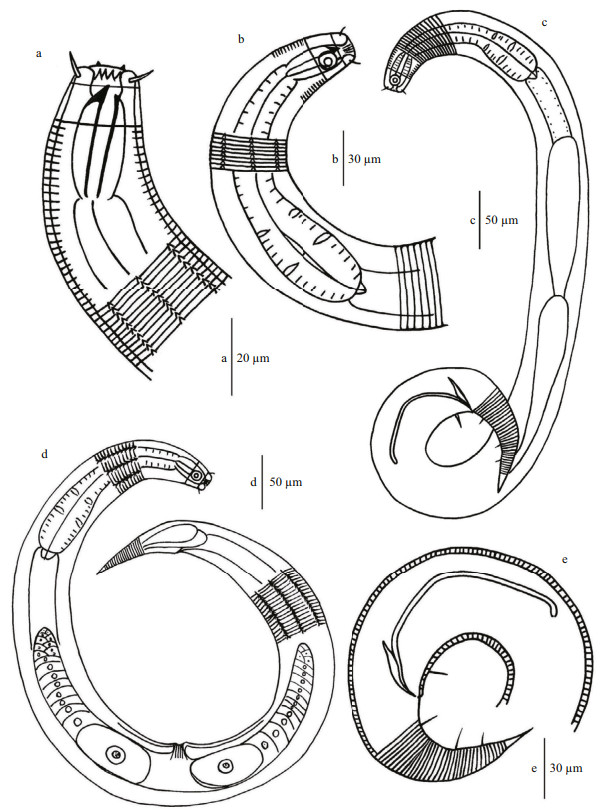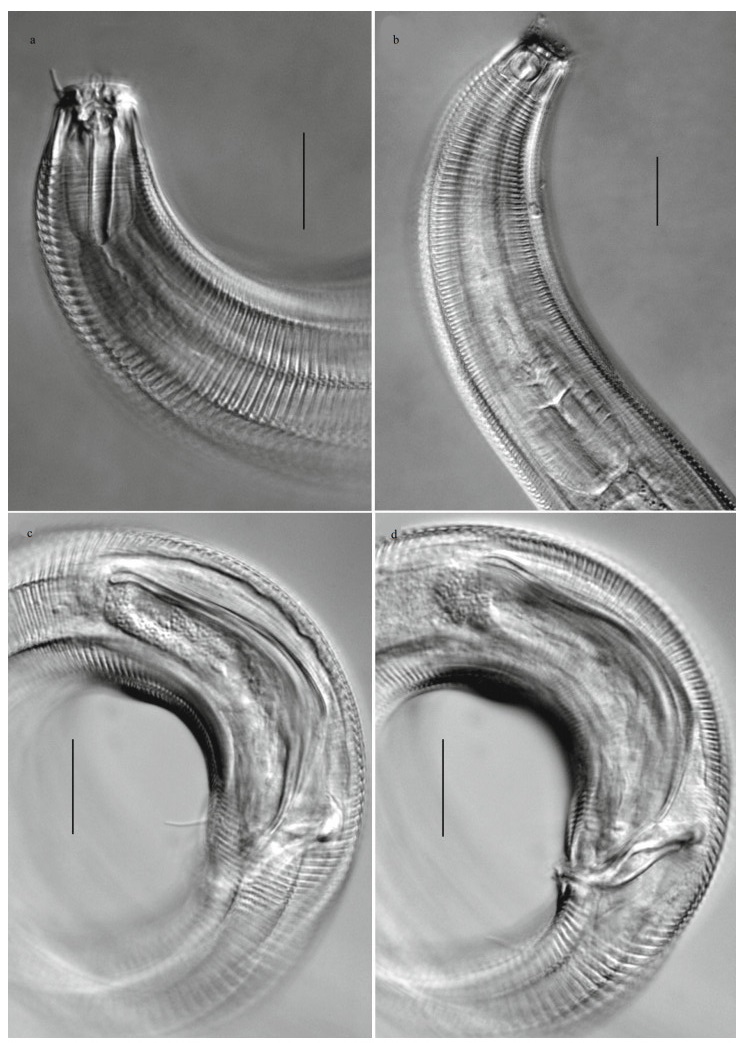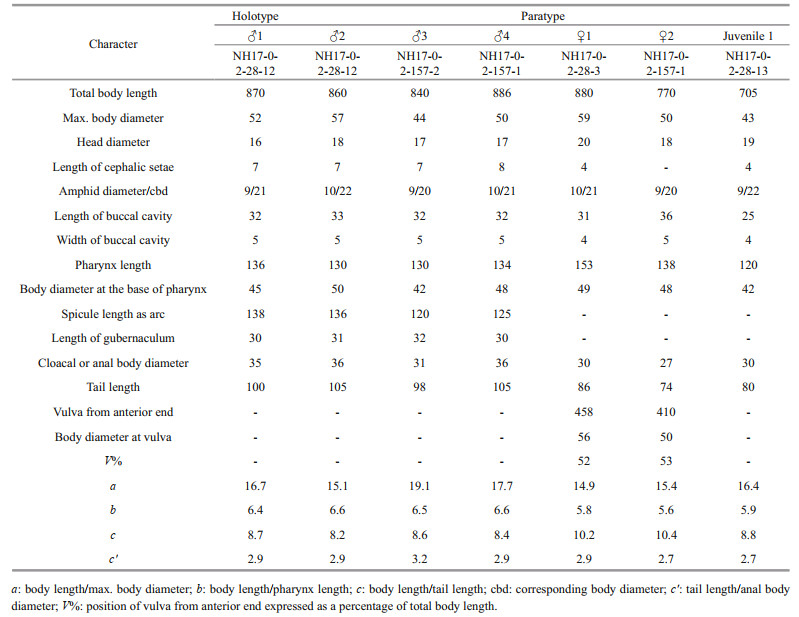Institute of Oceanology, Chinese Academy of Sciences
Article Information
- ZHAI Hongxiu, HUANG Mian, HUANG Yong
- A new free-living marine nematode species of Rhinema from the South China Sea
- Journal of Oceanology and Limnology, 38(2): 545-549
- http://dx.doi.org/10.1007/s00343-019-9169-7
Article History
- Received Jun. 24, 2019
- accepted in principle Aug. 2, 2019
- accepted for publication Aug. 9, 2019
2 Department of Marine Organism Taxonomy and Phylogeny, Institute of Oceanology, Chinese Academy of Sciences, Qingdao 266071, China;
3 University of Chinese Academy of Sciences, Beijing 100049, China
The genus Rhinema is a small and rare genus. At present, only two species have been recorded since it was proposed with the type species Rhinema retrorsum by Cobb in 1920. The two species are Rhinema retrorsum Cobb, 1920 (Cobb, 1920) and Rhinema exquisitum Timm, 1961 (Timm, 1961). The genus is characterized by cuticle thick and coarsely annulated. Longitudinal alae extending throughout the body. Anterior sensilla pattern in 6+6+4, both inner and outer labial sensilla as papilliform or setiform, cephalic sensilla setiform. Amphideal fovea circular, situated on the second annulus. Buccal cavity deep with a large dosal tooth opposed to small ventrosublateral teeth. Pharynx with posterior bulb. Spicules and gubernaculum present. Female with two ovaries (Tchesunov, 2014).
Seabed sediment samples were collected in many sites from intertidal to sublittoral regions during past few years with the aim to study the biodiversity of free-living marine nematodes in the South China Sea. More than 200 nematode species have been identified from these habitats (Huang et al., 2018, 2019b; Jia and Huang, 2019). Among them, an unrecorded species was identified and is described here as Rhinema longispicula sp. nov.
2 MATERIAL AND METHODIn February 2017, seafloor sediments were obtained from a grid of three sampling stations from Qiongzhou Strait in the South China Sea. The sediment was obtained using a Gray-O'Hara box corer, and the samples were taken using a sawn-off syringe with a 2.6-cm inner diameter. The samples were taken to a depth of 8 cm and divided into three sections, 0–2, 2–5, and 5–8 cm, then fixed with equivalent 10% formalin in seawater for long-term preservation. Sampling, sorting and slide mounting as already indicated in our previous papers (Huang et al., 2019a; Huang and Sun, 2019; Jia and Huang, 2019). All measurements are made using Leica LAS X version 3.3.3. All curved structures were measured along the arc. The type specimens are deposited in the Marine Biological Museum of Chinese Academy of Sciences, Qingdao.
3 SPECIES DESCRIPTIONOrder Desmodorida De Coninck, 1965
Family Monoposthiidae Filipjev, 1934
Genus Rhinema Cobb, 1920
Rhinema longispicula sp. nov (Figs. 1–2)

|
| Fig.1 Rhinema longispicula sp. nov. a. lateral view of male anterior end, showing buccal cavity and dorsal tooth; b. lateral view of male anterior end, showing amphideal fovea and pharyngeal bulb; c. entire view of male body, showing two testes; d. entire view of female body, showing ovaries and vulva; e. lateral view of male posterior end, showing spicules and gubernaculum. |

|
| Fig.2 Rhinema longispicula sp. nov. a. lateral view of male anterior end, showing buccal cavity, dorsal tooth and cephalic setae; b. lateral view of female anterior end, showing amphideal fovea and pharyngeal bulb; c. lateral view of male posterior end, showing spicules; d. lateral view of male tail end, showing gubernaculum (scale bar of a, b, c, d: 20 μm). |
Four males, two females, and six juveniles were obtained. Four males, two female and one juvenile measured. Holotype male on slide NH17-0-2-28-12. Paratypes on NH17-0-2-28-13, NH17-0-2-28-3 and NH17-0-2-157-1, NH17-0-2-157-2.
3.2 Type locality and habitatHolotype male and paratype males, females and juveniles were found at Station NH17-2 of Qiongzhou Strait, 13 m depth in silt-clay sediments, surface layer between 0–2 cm.
3.3 EtymologyThe species name composed of the Latin adjective longus (long) and the Latin noun spicule, referring to the elongate spicules of the species.
3.4 MeasurementAll measurement data are given in Table 1.

|
Body cylindrical with attenuated head end and conical tail end, 840–886 μm long. Greatest body diameter at the middle of body, 44–57 μm wide. Cuticle coarsely annulated, with 12 longitudinal ridges (alae) marked as V-shaped. The first and second annuli are broader and form a kind of a cephalic capsule. The lips well developed. The inner labial sensilla not observed; the six outer labial sensilla very short, papilliform. The four cephalic sensilla setiform, 7 μm long and situated at the basis of the lip region. The amphideal fovea circular, 9 μm diameter (41% of the corresponding body diameter), and located in the middle of the broad second annulus, not surrounded by dense annulations. Buccal cavity cylindrical and cuticularized, 32–33 μm long and 5 μm wider. One big dorsal tooth, two smaller ventro-sublateral teeth present. Pharynx muscular with a prominent anterior pharyngeal bulb and an elongated terminal bulb. Nerve ring not observed. Ventral gland and excretory pore not found. Tail conical with a non-annulated finger-like tail tip, 98–105 μm, i.e. 2.9–3.2 cloaca body diameter long. Two rows of longitudinal setae, 3–4 pairs, located along subventral portion of tail, each seta 8 μm long. Three contiguous caudal glands with a common opening.
Reproductive system with two testes arranged in tandem. Anterior testis located to left of the intestine, posterior one located to right of the intestine. Spicules elongate, strongly curved, cephalated proximally and pointed distally, 120–138 μm, i.e. 3.8–3.9 cloaca body diameter long. Gubernaculum (30–32)-μm long, boat-shaped, without apophysis. One blunt precloacal seta, 10-μm long. Precloacal supplement absent.
Females. Resembles males in most aspects except cephalic setae shorter, only 4-μm long, tail slightly shorter (74–86 μm, i.e. 2.7–2.9 anal body diameter long) and without caudal setae. Reproductive system didelphic with two opposed, outstretched ovaries. Uterus a wide tube. Vagina straight and cuticularized, 0.25 times vulval body diameters long. Vaginal glands present. Vulva with slightly raised lips and situated at just post-mid of body.
3.6 Differential diagnosis and discussionRhinema longispicula sp. nov. is characterized by coarsely annulated cuticle with 12 longitudinal ridges (alae) marked as reversed V-shaped. The first and second annuli broader and form a kind of a cephalic capsule. Circular amphideal fovea situated in the middle of the broad second annulus. Cylindrical buccal cavity with a large dorsal tooth. Pharynx with a prominent anterior pharyngeal bulb and an elongated terminal bulb. Elongate spicules strongly curved, cephalated proximally and pointed distally. Gubernaculum boat-shaped without apophysis. A stoutly precloacal seta present, precloacal supplement absent. Female with two opposed, outstretched ovaries. It differs from the other two known species of this genus, Rhinema retrorsum Cobb, 1920 and Rhinema exquisitum Timm, 1961 in having shorter cephalic setae and longer spicules. In Rhinema retrorsum, spicules shorter, only 45 μm, i.e. 1.5 cloacal body diameter long (Gerlach, 1963) (vs 120– 138 μm, i.e. 3.8–3.9 cloacal body diameter long). Rhinema exquisitum only found females, its amphideal fovea surrounded by dense annulations, cephalic setae 18 μm i.e. 1.3 times of head diameter long (vs 4–8 μm, i.e. 0.2–0.5 head diameter long).
4 DATA AVAILABILITY STATEMENTThe authors declare that the data supporting the findings of this study are available within the article. The data will be available on request from the corresponding author.
5 ACKNOWLEDGMENTThe authors are very thankful to all crew members of R/V Kexue 3 for their kind help in samples collection. We are sincerely grateful to two anonymous referees for providing valuable criticisms and improving on manuscript.
Cobb N A. 1920. One hundred new nemas (type species of 100 new genera). Contributions to a Science of Nematology, 9: 217-343.
|
Gerlach S A. 1963. Freilebende Meeresnematoden von den Malediven Ⅱ. Kieler Meeresforschungen, 19: 67-103.
|
Huang M, Jia S S, Huang Y. 2018. One new species and one new record of the species of the family Comesomatidae(Nematoda:Chromadorida) from the South China Sea. Zootaxa, 4504(1): 119-127.
DOI:10.11646/zootaxa.4504.1.6 |
Huang M, Sun J, Huang Y. 2019a. Daptonema parabreviseta sp. nov. (Xyalidae, Nematoda) from the Jiaozhou Bay of the Yellow Sea, China. Journal of Oceanology and Limnology, 37(1): 273-277.
DOI:10.1007/s00343-019-7362-3 |
Huang M, Xu K D, Huang Y. 2019b. Setosabatieria minor sp.nov. (Comesomatidae, Nematoda) from the South China Sea. Cahiers de Biologie Marine, 60(4): 387-393.
|
Huang Y, Sun J. 2019. Paramonohystera weihaiensis sp. nov.(Xyalidae, Nematoda) from the intertidal beach of the Yellow Sea, China. Journal of Oceanology and Limnology, 37(4): 1 403-1 408.
DOI:10.1007/s00343-019-8225-7 |
Jia S S, Huang Y. 2019. Elzalia heterospiculata sp. nov.(Nematoda:Monhysterida:Xyalidae) from the South China Sea. Zootaxa, 4603(3): 568-574.
DOI:10.11646/zootaxa.4603.3.9 |
Tchesunov A V. 2014. Order desmodorida de coninck, 1965.In: Schmidt-Rhaesa A ed. Handbook of Zoology, De Gruyter, Göttingen. p.399-434.
|
Timm R W. 1961. The marine nematodes of the Bay of Bengal. Proceedings of the Pakistan Academy of Sciences, 1(1): 1-88.
|
 2020, Vol. 38
2020, Vol. 38


